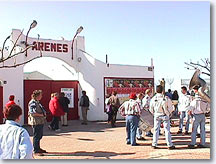| Ramblin' On with Pat Middleton |
The Gardians
of the Camargue |
|
| Author, Pat Middleton
continues her journey to find great waterway cruises for greatriver.com
travelers!
The Rhone River Delta The Camargue
|
The distinctive white horses and wild bulls are everywhere in the marsh. Manhood (meaning bragging rights in the local pubs) is earned by working with
these horses and bulls. Many of the local attractions offer visitors an
opportunity to see the Gardians in action, prodding the bulls with their long
working sticks (one wouldn't want to lasso on of these wild bulls) and cage-like Gilbert
Arnaud is a bull-breeder (or Manadier), one of only eleven old families in the Camargue who
can trace their families back to the Middle Ages. Since
the 16th century, his family has worked with the horses and bulls. With such
stature comes responsibility. For 18 years
he has been the Mayor of Stes.-Maries-de-la-Mer. Gilbert is concerned about the Camargue and its fragile environment. When politicians vacillated over whether or not to pass laws regulating the increased trucking of hazardous products through the Camargue, Gilbert threatened to walk his bulls through the streets of Stes Maries. The regulations were passed very quickly!
"Wear a dark jacket or sweater and the mosquitoes hover everywhere
around you," Stephanie noted. She is the wife of Gilbert, and works with
him on the Maas or ranch. She explains that the Camargue horses are very good
riding horses, and very serious about their work on the ranch. Until they are
taken out of the Camargue. Then they become restless,
instinctively wondering, she believes, "Where are the bulls? What work should I be doing
here?" The mares and young foal are always left wild to wander the marshes
for breeding. Only the males are used for riding. The bulls of the Camargue are culled at two years of age. Each is tested in the arena by local boys and graded for its fighting spirit. The bulls of the Camargue are not killed in the ring, but instead learn to fiercely defend the accolades which are attached to their horns. They might live as professionals (like professional rodeo horses in the US) for 15 years, participating in any one of the 800 bullfights scheduled each year in the vicinity of Stes Maries-de-la-Mer. At any time there might be 13 or 14 thousand bulls pastured in the Camargue as compared to perhaps 6 or 7 genuine champions in the entire history of bull fights in the Camargue. According to Stephanie, the bulls are never bred for slaughter, but for spirit in the arena. The rare champion is revered by locals and buried near the farm house and perhaps remembered with a statue.
Except for
the Gardian theme, accommodations at The *** Hotel L'Etrier were "all American," including
a crystal clear Olympic-sized pool and comfortable, well-maintained rooms with
bathrooms. As we found throughout S. France, nearly everyone spoke English.
In fact, Françoise Bouzet, the owner and a Swiss national, lives in Scottsdale, Arizona, during
Continue to Part 3 of 5:
|
[ Camargue Overview ]
[ Map of Camargue ] [ The Gardians
] [The
Gypsies ]
[ Birding ] [
Agriculture ] [Travel & Tourism
Info ]
Return to [ Waterway
Cruises ]
Return to [ The Mississippi River Home Page
]







